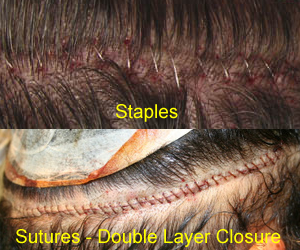What is the Most Optimal Hair Transplant Donor Closure Technique?
I was wondering if someone can briefly explain what donor closure technique is the best and can produce the finest scar in hair transplant surgery? Based on the discussions that I read on this hair loss forum, it seems like the trichophytic closure is by far the best technique to cover the donor area and reduce the scar but this is only true if you don’t need to have additional hair transplants. Also, what is the difference between a single and double layer closure technique? What about staples verses sutures? Is this a personal preference or is there a specific reason to perform such techniques?
Excellent Question.
Having observed surgery at dozens of leading hair restoration clinics, it is surprising that there is not one predominant school of thought on the optimal donor closure technique.


Typically the internal sutures are dissolvable, while the external skin layer sutures need to be removed.
Other physicians argue that internal sutures should only be used when the donor area is particularly tight due to either low scalp laxity and/or a wide strip being removed. They claim that internal sutures, which can take over a month to dissolve, can potentially create reactions or irritations, although very rare, under the scalp.
Other physicians choose to use staples rather than sutures because they believe that the staples are more secure and do not bind on the skin or strangulate the skin like sutures might.
As for the trichophytic closure, it is a nice final touch that can help disguise the final donor scar by having the hairs grow up and through the scarline. But if the scar is wider than pencil thin it really will have only marginal value. Thus it is no replacement for doing a fundamentally sound closure.
Some hair loss doctors opt not to perform a trichophytic closure when they expect the patient to do more sessions because they believe that that the trichophytic closure can result in follicles along the scarline becoming somewhat contorted, which can make them harder to trim into viable hair grafts.
At the upcoming annual ISHRS (International Society of Hair Restoration Surgeons) meeting of hair transplant physicians in September, the appropriate implementation of the trichophytic closure is a dedicated topic. It will be interesting to hear the pro and con debate.
Personally, having had both sutures and staples, and seen dozens of surgeries and results, I believe the double layer closure with trichophytic closure is optimal.
I’ve always been impressed at how easily the skin comes together with virtually no tension when underlying internal sutures are used. Thus there is virtually no binding or tension on the external sutures.
The underlying internal sutures also remain in place for much longer than ten day and thus minimize the danger of donor scar stretching. Sutures are also much more comfortable, especially during their removal, in my experience and from what I have heard from dozens of other patients.
A double layer suture with trichophytic closure takes the most time of any closure technique. But in my non MD opinion, it is the most comfortable and optimal closure technique for the patient.
Pat Hennessey,
Publisher of the Hair Transplant Network and the Hair Loss Learning Center
Technorati Tags: hair transplant, hair loss, trichophytic closure, hair transplants, hair restoration, double layer closure, donor scar, hair loss doctor, hair grafts, ISHRS, International Society of Hair Restoration Surgeons, hair transplant physicians, scar stretching
Recent Posts
Pinco ?????? ??????????? ?????? ??? Android ? ??? iPhone
???????? ???????? ? ??????????? ??????? ????? ??????????? ???????? ????????? ??? ??????. ? ????? https://www.nextgenerationconstructionltd.com/2025/04/10/bonusy-v-kazino-pinko-na-segodnya-vyshe-registratsiyu-bezmezdnye-vrashcheniya/ ????????…
??????? ??? ????? ??????????? ????, ????????? ?? ???????, ???? ??????? ???????? ???? ???????? ??????
????? ? ???????????? ???????????? ?????????????????? ????? ??? ??????????. ??? ????????? ????????? ?????? ??????? ??? ???????…
output_9282
Paribahis çevrimiçi Bahis markas?, paribahis giri? net üzerinden oyun alternatifi ve canl? oyun pazar?nda hizmet…
?????? ?? ??????? ??? ????? ????????????? ????? ?? ??????? ??? ???????????
???????? ???????? ???????? ????? ????????????? ????????? ??? ?????? ? ????? ???? ? ?????????. ????????? ????????…
Real money play at Australian and New Zealand’s online casino stay casino australia
The Australian and New Zealand online gambling site stay casino delivers players an engaging experience…
En Güvenli Casino Siteleri Hangileri?: Sweet Bonanza Casino Tavsiyesi
2025 yýlýnda SweetBonanza kumarhane platformu, kaliteli casino siteleri listesinde bulunuyor ve geliþtirilen oyun seçenekleri ve…



